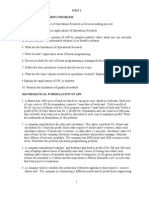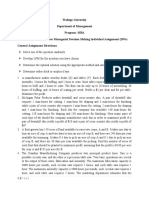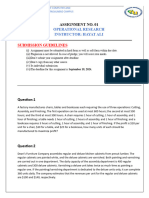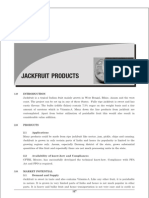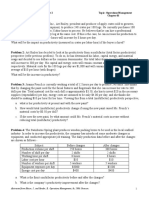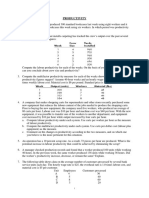Problem Solving Week 2
Problem Solving Week 2
Uploaded by
Ahmed RaeisiCopyright:
Available Formats
Problem Solving Week 2
Problem Solving Week 2
Uploaded by
Ahmed RaeisiCopyright
Available Formats
Share this document
Did you find this document useful?
Is this content inappropriate?
Copyright:
Available Formats
Problem Solving Week 2
Problem Solving Week 2
Uploaded by
Ahmed RaeisiCopyright:
Available Formats
Weekly Activities 2
1. If machines at Frito-Lay are designed to 2,000 bags of chips/hr., and the plant operates 12hrs./day,
what will be the design capacity
2. If machines at Frito-Lay are designed to 3,000 bags of chips/hr., and the plant operates 10hrs./day
but due to issues in the capacity there was 10% of designed capacity became lowered, what will be
the design capacity ?
3. If Frito-Lay loses 2 hours of output per day and design capacity was 3000 chips/hr and the plant
operates 10hrs. What will be the effective capacity?
4. If Frito-Lay loses 3 hours of output per day and design capacity was 3000 chips/hr and the plant
operates 10hrs, but due to some issues the design capacity also was lowered 5%. What will be the
effective capacity?
5. There are 2 shifts. On average, if machines at Frito-Lay are not running 2 hr./shift due to late parts
and machine breakdowns and the plant operates 10hrs , what will be the actual output when design
capacity was 5000 chips/hr.
6. Sara James Bakery has a plant for processing Deluxe breakfast rolls and wants to better understand
its capability. Last week the facility produced 158,000 rolls. The effective capacity is 175,000 rolls.
The production line operates 6 days per week, with three 6-hour shifts per day. The line was
designed to process the nut-filled, cinnamon-flavored Deluxe roll at a rate of 1,300 per hour.
Determine the design capacity, utilization, and efficiency for this plant when producing this Deluxe
roll.
7. Sara James Bakery has a plant for processing Deluxe breakfast rolls and wants to better understand
its capability. Last week the facility produced 150,000 rolls. The production line operates 6 days per
week, with two 6-hour shifts per day. The line was designed to process the nut-filled, cinnamon-
flavored Deluxe roll at a rate of 1,500 per hour. Due to Determine the design capacity, effective
capacity, utilization, efficiency, expected output for this plant when producing this Deluxe roll.
Scenario 1: Alex's Handmade Candles
Alex has always been passionate about creating unique and scented candles. He decides to turn this hobby into a
business and set up a small shop. To determine the viability of his venture, he wishes to calculate his break-even
point.
Data:
1. Fixed Costs: Rent for the shop, initial marketing campaigns, and administrative costs sum up to $8,000 per
year.
2. Direct Labour: Alex decides to employ a helper for which he sets aside a labour cost of $1.00 per candle.
3. Material Costs: The wax, fragrance, wicks, and other materials cost Alex $0.60 per candle.
4. Selling Price: After doing a market survey, Alex decides to sell each candle for $3.50.
Tasks: Calculate BEP$ and BEPx
Scenario 2: Maria's Organic Skincare
Maria, a dermatologist, wishes to launch her line of organic skincare products, starting with a moisturising cream.
Before mass-producing, she wants to gauge the financial metrics and find her break-even point.
Data:
1. Fixed Costs: Licensing, lab testing, and initial promotional costs are estimated to be $15,000 annually.
2. Direct Labour: Packaging and quality testing cost Maria $2.00 per cream container.
3. Material Costs: Organic ingredients, preservatives, and the container cost total up to $3.00 per unit.
4. Selling Price: Based on perceived value and competitor pricing, Maria decides on a selling price of $10.00 per
container.
Tasks: Calculate BEP$ and BEPx
You might also like
- AMOS Training Manual REV 0 20122022Document39 pagesAMOS Training Manual REV 0 20122022Víctor Bernabeu Ramia75% (4)
- Linear ProgrammingDocument27 pagesLinear ProgrammingBerkshire Hathway cold100% (1)
- A Garment Manufacturer Has A Production Line Making Two Styles of ShirtsDocument2 pagesA Garment Manufacturer Has A Production Line Making Two Styles of ShirtsKavitha Dhas100% (1)
- OR Question BankDocument29 pagesOR Question BankSuhas Mv50% (4)
- Name: Syed Wajahat Abbas Reg#: 10466 Operation ManagementDocument4 pagesName: Syed Wajahat Abbas Reg#: 10466 Operation Managementammar abbas100% (1)
- Problems 1Document4 pagesProblems 1vishwajeetg50% (2)
- Linear Programming Exercises: Setup The LP Models For The FollowingDocument3 pagesLinear Programming Exercises: Setup The LP Models For The Followingbackup cmbmpNo ratings yet
- Ch01 Problems RevDocument4 pagesCh01 Problems RevHetty Mustika0% (3)
- Beautiful Workshop (Capacity)Document1 pageBeautiful Workshop (Capacity)camilaNo ratings yet
- Problems ADocument3 pagesProblems AMuhammad Nurudin IslamiNo ratings yet
- Utilization Efficiency Solved ProblemDocument2 pagesUtilization Efficiency Solved ProblemFalisha ArshadNo ratings yet
- Pinansilo Let S Analyze Ulo B Week 6 7 Ge 4 4247Document13 pagesPinansilo Let S Analyze Ulo B Week 6 7 Ge 4 4247Vhinz PelenioNo ratings yet
- Assignment 1 OrDocument4 pagesAssignment 1 OrSeid YesufNo ratings yet
- Individual AssignmentDocument14 pagesIndividual AssignmentTamiru BeyeneNo ratings yet
- OR Sheet 2Document3 pagesOR Sheet 2krmheheNo ratings yet
- MGT 208 Management Science Activity 2.1Document3 pagesMGT 208 Management Science Activity 2.1Hailsey WinterNo ratings yet
- PDF QT Practice SetDocument13 pagesPDF QT Practice Setpankaj5470100% (1)
- Exercise LPGSDocument1 pageExercise LPGSShamima ShishirNo ratings yet
- Assignment 1Document4 pagesAssignment 1Ayesha NaseerNo ratings yet
- 3.31.14 Linear Programming ProjectDocument3 pages3.31.14 Linear Programming ProjectRA SmiNo ratings yet
- Or Question BankDocument3 pagesOr Question BankshhNo ratings yet
- Problems Discuss in The ClassDocument11 pagesProblems Discuss in The Classbharath100% (1)
- Set III Large LPP ProblemsDocument5 pagesSet III Large LPP Problemsabhishek kushwahaNo ratings yet
- Capacity Planning Chapter5 Feb 11Document44 pagesCapacity Planning Chapter5 Feb 11JOANNECHUNo ratings yet
- Operation Research Exercise PDFDocument9 pagesOperation Research Exercise PDFSerkalem AsfawNo ratings yet
- AssignmentDocument3 pagesAssignmentbinilucky224No ratings yet
- Assignment 1Document6 pagesAssignment 1John Does0% (1)
- Probset in Graphical MethodDocument1 pageProbset in Graphical MethodRuthchell CiriacoNo ratings yet
- Practice QuestionsDocument2 pagesPractice QuestionsTrisha SARMIENTONo ratings yet
- 04 Examples & Cases On LP Model Formulation-1Document7 pages04 Examples & Cases On LP Model Formulation-1Samiksha SinghNo ratings yet
- Evaluation Second Cut OffDocument7 pagesEvaluation Second Cut OffLaura RodriguezNo ratings yet
- Practice Questions For Graphical MethoD or Simplex MethoDDocument2 pagesPractice Questions For Graphical MethoD or Simplex MethoDNazir Ansari100% (1)
- Assignment I On LPDocument3 pagesAssignment I On LPabraha gebruNo ratings yet
- Practice Problems and Cases On LPPDocument7 pagesPractice Problems and Cases On LPPSIRSHA PATTANAYAKNo ratings yet
- Production Management IA QuestionsDocument4 pagesProduction Management IA QuestionsAWENABAH THOMASNo ratings yet
- Tutorial 1Document7 pagesTutorial 1MyameSirameNo ratings yet
- Iv. Technical Aspect 4.1 ProductDocument6 pagesIv. Technical Aspect 4.1 ProductFaith LacreteNo ratings yet
- Activity 1Document2 pagesActivity 1DENZ RAYMOND LACUESTANo ratings yet
- Productivity ExercisesDocument1 pageProductivity ExercisesMuhammad BilalNo ratings yet
- Jackfruit ProductDocument9 pagesJackfruit Productjosephtitty100% (1)
- Management Science PDFDocument9 pagesManagement Science PDFNahom Girma100% (1)
- OR - Assignment 1 Problem FormulationDocument4 pagesOR - Assignment 1 Problem FormulationSama AhmedNo ratings yet
- LP ProblemsDocument1 pageLP ProblemsMarie Casilac100% (1)
- Linear Programming Part 1Document20 pagesLinear Programming Part 1roan.fairrayosNo ratings yet
- SCM ProbDocument6 pagesSCM ProbRhoel YadaoNo ratings yet
- Asia, John Romme BSMA 2-10 9.2Document5 pagesAsia, John Romme BSMA 2-10 9.2Bernard T. AsiaNo ratings yet
- Business Problems Based On DSSDocument4 pagesBusiness Problems Based On DSSShivam SinghNo ratings yet
- Operations Research Sheet 1Document5 pagesOperations Research Sheet 1Muhammed FikiNo ratings yet
- Tutorial 07-Operations and Productivity PDFDocument2 pagesTutorial 07-Operations and Productivity PDFKhiren Menon100% (1)
- Lesson 2Document6 pagesLesson 2Carlos Jan P. PenasNo ratings yet
- Economic Analysis of Coconut Shell PelletizingDocument3 pagesEconomic Analysis of Coconut Shell PelletizingJossie XiongNo ratings yet
- Lecture 7Document11 pagesLecture 7tumurnoor6No ratings yet
- Assignment 3Document1 pageAssignment 3Raj PillaiNo ratings yet
- Linear ProgrammingDocument12 pagesLinear ProgrammingAsfiya Islam AbirNo ratings yet
- Productivity CompressDocument10 pagesProductivity CompresstayerNo ratings yet
- Chapter 2: Productivity Measure (Monday) Answer All QuestionsDocument1 pageChapter 2: Productivity Measure (Monday) Answer All QuestionsImran RashidNo ratings yet
- Project Report Ambhuja S RDocument11 pagesProject Report Ambhuja S RHarishNo ratings yet
- Case 2 - Daily Bread CoDocument2 pagesCase 2 - Daily Bread CoQurat Ul Ain NaqviNo ratings yet
- Coco Seedling Business PlanDocument14 pagesCoco Seedling Business PlanJohnmark GullesNo ratings yet
- Coco Seedling Business PlanDocument14 pagesCoco Seedling Business PlanJohnmark GullesNo ratings yet
- Ask Ed: Marijuana Success: Tips and Advice for Gardening Year-RoundFrom EverandAsk Ed: Marijuana Success: Tips and Advice for Gardening Year-RoundRating: 5 out of 5 stars5/5 (1)
- 6.14 - Manual - Ford Linc Mercury P.183 260 PDFDocument78 pages6.14 - Manual - Ford Linc Mercury P.183 260 PDFDaniel TorresNo ratings yet
- Rujukan Group FinalDocument4 pagesRujukan Group FinalNazliana ZakariaNo ratings yet
- FM End-Sem Question Paper - 2021Document1 pageFM End-Sem Question Paper - 2021Anshu MeenaNo ratings yet
- RSCH 122 Week 11 19Document5 pagesRSCH 122 Week 11 19MemisaNo ratings yet
- Download full Exploring the Psycho Social Impact of COVID 19 Global Perspectives on Behaviour Interventions and Future Directions 1st Edition Rajesh Verma Uzaina Uzaina Sam Manickam Tushar Singh Gyanesh Tiwari Uzaina ebook all chaptersDocument62 pagesDownload full Exploring the Psycho Social Impact of COVID 19 Global Perspectives on Behaviour Interventions and Future Directions 1st Edition Rajesh Verma Uzaina Uzaina Sam Manickam Tushar Singh Gyanesh Tiwari Uzaina ebook all chapterswijscapois100% (4)
- PSPD 3Document56 pagesPSPD 3TECHIFY CARTOONSNo ratings yet
- Rosalie DallongDocument116 pagesRosalie Dallongkram kolNo ratings yet
- Armis - 2021 - ISO 27001 - Certification Transfer - Final CertificateDocument2 pagesArmis - 2021 - ISO 27001 - Certification Transfer - Final CertificateHuynh KimNganNo ratings yet
- B.Tech Minor Project ReportDocument34 pagesB.Tech Minor Project ReportAryan AroraNo ratings yet
- Brgy Resolution Als Realignment - NAHAPUNAN YDFDocument3 pagesBrgy Resolution Als Realignment - NAHAPUNAN YDFYuki MendezNo ratings yet
- E Comm FirewallDocument28 pagesE Comm FirewallALOKNo ratings yet
- Excavation SafetyDocument31 pagesExcavation SafetyAhmad AliNo ratings yet
- UVM Based Subsystem - FIFODocument5 pagesUVM Based Subsystem - FIFOjoshi zizjoNo ratings yet
- Amount of Fading RevisitedDocument23 pagesAmount of Fading RevisitedMurthy NarasimhaNo ratings yet
- 25 Statement of Financial Position- Sample Answers to Short Answer and Data Response Question 1Document2 pages25 Statement of Financial Position- Sample Answers to Short Answer and Data Response Question 1Aariish SinghiNo ratings yet
- BlinkIT Grocery DataDocument570 pagesBlinkIT Grocery DatadeepakvasudevanNo ratings yet
- Couplings: The Perfect Through Wall ConnectionDocument7 pagesCouplings: The Perfect Through Wall ConnectionOnur ÖzdemirNo ratings yet
- Flow Through A Pipe: CFD Assignment 1Document7 pagesFlow Through A Pipe: CFD Assignment 1Navnoor BrarNo ratings yet
- MTG12-05 Forklift Inspection ChecklistDocument3 pagesMTG12-05 Forklift Inspection ChecklistLuis De La HozNo ratings yet
- NHSL 203231 Labs IT Operational Manager Job DescriptionDocument9 pagesNHSL 203231 Labs IT Operational Manager Job DescriptionJohn LoveNo ratings yet
- PWS6500 Hardware ManualDocument15 pagesPWS6500 Hardware ManualOmar Alberto Quisbert Tapia100% (1)
- Hydrogen SulfideDocument151 pagesHydrogen SulfidereddygrNo ratings yet
- SQR FAQ's - CDocument24 pagesSQR FAQ's - Cabhi10augNo ratings yet
- McCoyGlobalCatalog LowRes PDFDocument60 pagesMcCoyGlobalCatalog LowRes PDFAndres SanchezNo ratings yet
- Item 1,2 - CatalogDocument3 pagesItem 1,2 - CatalogBa Duy NguyenNo ratings yet
- Prelude For Organizational Efficiency: Cost ConsciousnessDocument40 pagesPrelude For Organizational Efficiency: Cost ConsciousnessSankalp SinghNo ratings yet
- Vivacity PortfolioDocument16 pagesVivacity PortfoliosamuelNo ratings yet
- Mungal (2014) - Linking Theory DiscussionDocument1 pageMungal (2014) - Linking Theory Discussionsolconcepcion043No ratings yet



